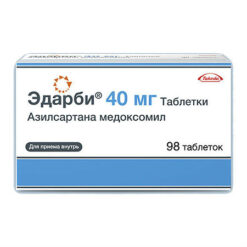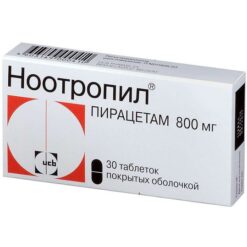No products in the cart.
Nootropil, 200 mg/ml 125 ml
€1.00
Out of stock
(E-mail when Stock is available)
Description
Pharmacotherapeutic group:
Notropic agent.
ATC code: N06BX03.
Pharmacological properties
Pharmacodynamics.
The active component of Nootropil is piracetam, a cyclic derivative of gamma-aminobutyric acid (GABA). Piracetam is a nootropic which directly affects the brain, improving cognitive processes such as learning, memory, attention and mental performance.
Notropil affects the central nervous system in different ways: by changing the speed of excitation distribution in the brain, improving metabolic processes in nerve cells; improving microcirculation, affecting blood rheological characteristics and causing no vasodilator effect. It improves connections between cerebral hemispheres and synaptic conduction in neocortical structures, increases mental performance, improves cerebral blood flow.
Piracetam inhibits platelet aggregation and restores the elasticity of the red blood cell membrane, reduces red blood cell adhesion. At a dose of 9.6 g, it reduces the level of fibrinogen and Villibrant factors, by 30%-40% and prolongs bleeding time.
Piracetam has a protective effect, improves brain functions impaired due to hypoxia and intoxication.
Piracetam reduces the severity and duration of vestibular nystagmus.
Pharmacokinetics.
In oral administration piracetam is quickly and almost completely absorbed, the peak concentration is reached 1 hour after administration. Bioavailability of the drug is approximately 100%. After a single dose of 2 g, the maximum concentration is 40-60 mcg/ml, which is reached in the blood after 30 minutes and in cerebrospinal fluid after 5 hours after intravenous injection. The apparent volume of distribution of piracetam is about 0.6 l/kg.
Half-life of the drug from plasma is 4-5 hours and 8.5 hours from cerebrospinal fluid, which is prolonged in renal insufficiency. Pharmacokinetics of piracetam does not change in patients with hepatic insufficiency. It penetrates through the blood-brain and placental barrier and membranes used in hemodialysis.
In animal studies piracetam selectively accumulates in tissues of the cerebral cortex, mainly in the frontal, parietal and occipital lobes, in the cerebellum and basal ganglia. It does not bind with blood plasma proteins, is not metabolized in the body and is excreted unchanged by the kidneys. 80-100% of piracetam is excreted unchanged by the kidneys through renal filtration. Renal clearance of piracetam in healthy volunteers is 86 ml/min.
Indications
Indications
– Symptomatic treatment of psychoorganic syndrome, in particular in elderly patients suffering from memory loss, dizziness, decreased concentration and general activity, mood changes, behavior disorder, gait disturbance, as well as in patients with Alzheimer’s disease and senile dementia of the Alzheimer’s type.
– Treatment of the consequences of stroke, such as speech disorders, emotional disturbances, to increase motor and mental activity.
– Chronic alcoholism – for the treatment of psychoorganic and withdrawal syndromes.
– The recovery period after comatose states, including after injuries and intoxications of the brain.
– Treatment of dizziness and related balance disorders, with the exception of dizziness of vascular and mental origin.
– As part of complex therapy for learning disabilities in children with psychoorganic syndrome.
– For the treatment of cortical myoclonus as mono- or complex therapy.
– In the complex therapy of sickle cell anemia.
Pharmacological effect
Pharmacological effect
Pharmacotherapeutic group:
nootropic agent.
ATX code: N06BX03.
Pharmacological properties
Pharmacodynamics.
The active component of Nootropil is piracetam, a cyclic derivative of gamma-aminobutyric acid (GABA). Piracetam is a nootropic that directly affects the brain, improving cognitive processes such as learning, memory, attention, and mental performance.
Nootropil influences the central nervous system in various ways: by changing the speed of propagation of excitation in the brain, improving metabolic processes in nerve cells; improving microcirculation, affecting the rheological characteristics of the blood and without causing a vasodilator effect. Improves connections between the cerebral hemispheres and synaptic conduction in neocortical structures, increases mental performance, and improves cerebral blood flow.
Piracetam inhibits platelet aggregation and restores the elasticity of the erythrocyte membrane, reduces the adhesion of erythrocytes. At a dose of 9.6 g, it reduces the level of fibrinogen and Willibrant factors by 30%-40% and prolongs bleeding time.
Piracetam has a protective effect, improves brain functions impaired due to hypoxia and intoxication.
Piracetam reduces the severity and duration of vestibular nystagmus.
Pharmacokinetics.
When taking the drug orally, piracetam is quickly and almost completely absorbed, peak concentrations are reached 1 hour after administration. The bioavailability of the drug is approximately 100%. After taking a single dose of 2 g, the maximum concentration is 40-60 mcg/ml, which is achieved in the blood after 30 minutes and 5 hours in the cerebrospinal fluid after intravenous administration. The apparent volume of distribution of piracetam is about 0.6 l/kg.
The half-life of the drug from blood plasma is 4-5 hours and 8.5 hours from cerebrospinal fluid, which is prolonged in case of renal failure. The pharmacokinetics of piracetam does not change in patients with liver failure. Penetrates the blood-brain and placental barrier and membranes used in hemodialysis.
In animal studies, piracetam selectively accumulates in the tissues of the cerebral cortex, mainly in the frontal, parietal and occipital lobes, in the cerebellum and basal ganglia. Does not bind to blood plasma proteins, is not metabolized in the body and is excreted unchanged by the kidneys. 80-100% of piracetam is excreted unchanged by the kidneys by renal filtration. The renal clearance of piracetam in healthy volunteers is 86 ml/min.
Special instructions
Special instructions
Caution should be exercised when prescribing the drug to patients with impaired hemostasis, during major surgery, or to patients with symptoms of severe bleeding.
When treating patients with cortical myoclonus, abrupt discontinuation of therapy should be avoided, because this may cause the attacks to recur.
During long-term therapy in elderly patients, regular monitoring of renal function indicators is recommended; if necessary, dose adjustment is carried out depending on the results of a creatinine clearance study.
Nootropil penetrates through the filter membranes of hemodialysis machines.
Impact on the ability to drive vehicles and operate machinery
Taking into account possible undesirable effects, the patient should be careful when operating machinery and driving a car.
Active ingredient
Active ingredient
Piracetam
Composition
Composition
Active substance:
piracetam – 200 mg/ml.
Excipients: glycerol 85%, sodium saccharin, sodium acetate, methyl parahydroxybenzoate, propyl parahydroxybenzoate, 52247/A apricot (flavor), 52939/A caramel (flavor), glacial acetic acid, purified water.
Pregnancy
Pregnancy
Animal studies did not reveal any damaging effects on the embryo and its development, including in the postnatal period, and did not change the course of pregnancy and childbirth.
No studies have been conducted in pregnant women.
Piracetam penetrates the placental barrier and into breast milk.
The concentration of the drug in newborns reaches 70-90% of its concentration in the mother’s blood. Except in special circumstances, Nootropil should not be prescribed during pregnancy.
You should refrain from breastfeeding when a woman is prescribed piracetam.
Contraindications
Contraindications
– Individual intolerance to piracetam or pyrrolidone derivatives, as well as other components of the drug.
– Acute cerebrovascular accident (hemorrhagic stroke).
– End-stage renal failure (with creatinine clearance less than 20 ml/min).
– Children’s age up to 1 year (for oral solution, 200 mg/ml) and up to 3 years (for capsules and tablets).
Side Effects
Side Effects
From the side of the central nervous system: hyperkinesia (1.72%), nervousness (1.13%), drowsiness (0.96%), depression (0.83%), asthenia (0.23%). These side effects occur more often in elderly patients receiving the drug at a dose of more than 2.4 g/day.
In some cases – dizziness, headache, ataxia, imbalance, exacerbation of epilepsy, insomnia, confusion, agitation, anxiety, hallucinations, increased sexuality.
From the metabolic side: increase in body weight (1.29%).
From the digestive system: in some cases – nausea, vomiting, diarrhea, abdominal pain.
Dermatological reactions: dermatitis, itching, rash, swelling.
Overdose
Overdose
When taking 75 g of piracetam in dosage form, oral solution, dyspeptic symptoms were noted, such as diarrhea, blood and abdominal pain, which are most likely associated with a high sorbitol content. No other special symptoms of piracetam overdose were noted.
Immediately after a significant oral overdose, you can lavage the stomach or induce artificial vomiting.
Treatment is symptomatic, which may include hemodialysis. There is no specific antidote. The effectiveness of hemodialysis is 50%-60% for piracetam.
Storage conditions
Storage conditions
At a temperature not exceeding 30 °C
Shelf life
Shelf life
5 years
Manufacturer
Manufacturer
NextPharma S.a.S., France
Additional information
| Shelf life | 5 years |
|---|---|
| Conditions of storage | At a temperature not exceeding 30 °C |
| Manufacturer | NextPharma S.a.S., France |
| Medication form | oral solution |
| Brand | NextPharma S.a.S. |
Other forms…
Related products
Buy Nootropil, 200 mg/ml 125 ml with delivery to USA, UK, Europe and over 120 other countries.
















